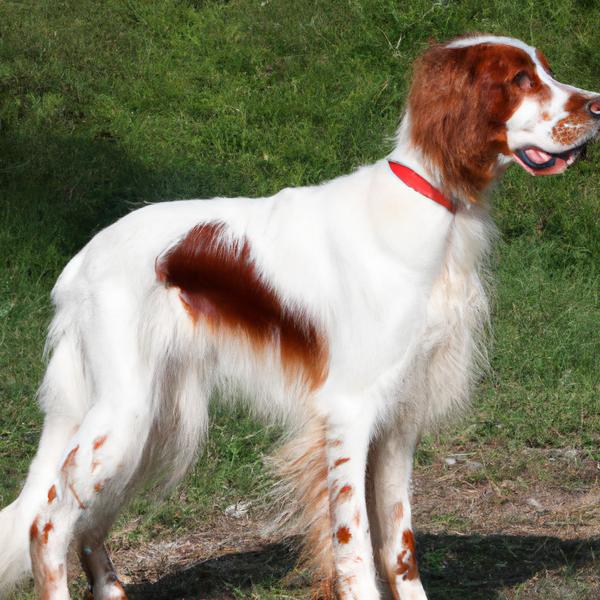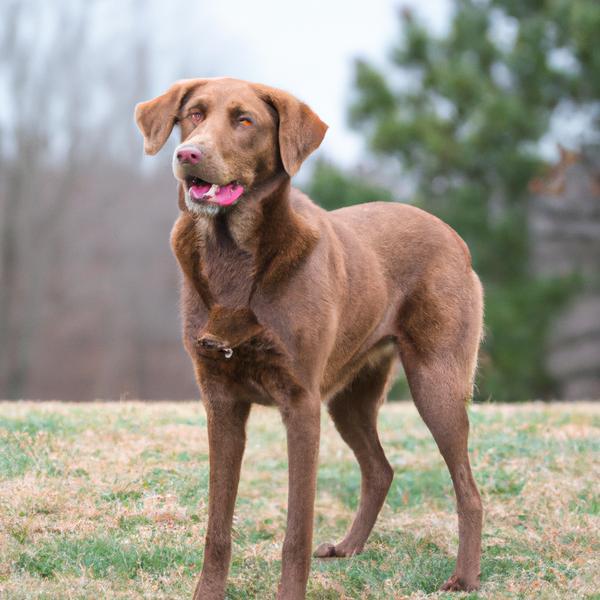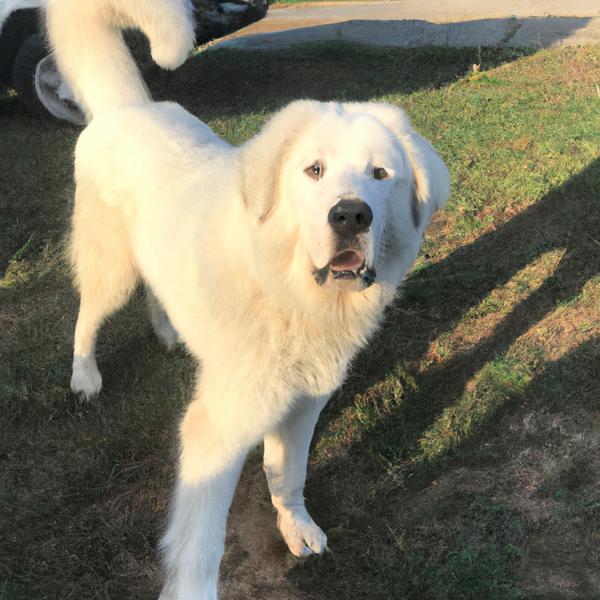Chesapeake Bay Retriever vs. Great Pyrenees: Breed Differences and Similarities
Weight Gain Potential
Which breed eats more: Chesapeake Bay Retriever or Great Pyrenees?
Both the Chesapeake Bay Retriever and Great Pyrenees breeds have an average to high tendency to gain weight if their weight is not closely monitored. It is important to maintain a balance between exercise and food intake to keep them at a healthy weight. This can be achieved by scheduling at least one daily walk and engaging in regular playtime with them.
Hypoallergenic
Are Chesapeake Bay Retrievers or Great Pyreneess hypoallergenic, or neither?
Unfortunately, neither Chesapeake Bay Retriever nor Great Pyrenees are hypoallergenic, which may not make them the best choice for dog lovers who suffer from pet allergies.
Temperament
What are the personalities of Chesapeake Bay Retriever and Great Pyrenees dogs?
Happy
Dominant
Protective
Affectionate
Intelligent
Quiet
Affectionate
Fearless
Patient
Confident
Gentle
Strong
Willed
Shedding Level
Do Chesapeake Bay Retrievers shed more than Great Pyreneess, or which breed sheds more, Chesapeake Bay Retrievers or Great Pyreneess?
Chesapeake Bay Retrievers are moderate shedders, but regular brushing can reduce shedding and maintain coat health.
Great Pyreneess are heavy shedders, but regular brushing can help manage shedding and promote a healthy coat.
Watchdog Ability
Which dog breed makes a better watchdog, the Chesapeake Bay Retriever or Great Pyrenees?
Chesapeake Bay Retrievers are decent watchdogs - they'll alert their owner if something seems amiss.
Choose a Great Pyrenees if you want a top-notch watchdog. This breed takes guarding seriously, and may not require much training, though obedience or guard dog training can improve their skills.
Origin
What is the origin of Chesapeake Bay Retriever and Great Pyrenees dog breeds?
United States
Asia
Ancestry
What are the origins of Chesapeake Bay Retriever and Great Pyrenees breeds?
Newfoundland dog
Hungarian Kuvasz, Maremmano-Abruzzese
Breed recognition
Which kennel clubs recognize/register Chesapeake Bay Retriever and Great Pyrenees?
American Canine Registry
American Kennel Club
America's Pet Registry
Canadian Kennel Club
Dog Registry of America Inc.
Federation Cynologique Internationale
Kennel Club of Great Britain
North American Purebred Registry, Inc.
American Canine Association, Inc.
Australian National Kennel Council
Continental Kennel Club
National Kennel Club
New Zealand Kennel Club
United Kennel Club
American Canine Registry
American Kennel Club
America's Pet Registry
Canadian Kennel Club
Dog Registry of America Inc.
Federation Cynologique Internationale
Kennel Club of Great Britain
North American Purebred Registry, Inc.
American Canine Association, Inc.
Australian National Kennel Council
Continental Kennel Club
National Kennel Club
New Zealand Kennel Club
United Kennel Club
Date of Birth
When were Chesapeake Bay Retriever and Great Pyrenees breeds first developed?
1800s
Ancient Times
Breed Group
What is the Breed Group of Chesapeake Bay Retriever and Great Pyrenees?
Sporting (AKC:1878)
Gundog (UKC)
Working (AKC:1933)
Guardian Dogs (UKC)
Eye Color Possibilites
What are the eye colors of Chesapeake Bay Retriever and Great Pyrenees dogs?
Brown
Amber
Brown
Nose Color Possibilites
What are the natural nose colors of Chesapeake Bay Retriever and Great Pyrenees?
Brown
Black
Coat Color Possibilites
What are the natural colors of the coat for Chesapeake Bay Retriever and Great Pyrenees breeds?
Brown
Red
White
Cream
Coat Length
What is the typical coat length for Chesapeake Bay Retriever and Great Pyrenees breeds?
Chesapeake Bay Retrievers have coats that can be either short or medium in length.
Great Pyreneess have longer coats compared to most dogs.
Coat Density
What is the density of the coat of Chesapeake Bay Retriever and Great Pyrenees?
Coat Texture
What is the hair texture of Chesapeake Bay Retriever and Great Pyrenees?
Wavy
Litter Size
What is the usual litter size for Chesapeake Bay Retriever and Great Pyrenees?
A Chesapeake Bay Retriever can have a litter of 10-13 puppies on average. However, it's worth noting that the size of the litters can vary greatly. Factors that can influence litter size include the health of the mother, breeding history, and genetics.
A Great Pyrenees can have a litter of 10-12 puppies on average. However, it's worth noting that the size of the litters can vary greatly. Factors that can influence litter size include the health of the mother, breeding history, and genetics.
Adaptability
Chesapeake Bay Retrievers have average adaptability to changes in lifestyle and living environments compared to other breeds.
Great Pyreneess are known for their adaptability and can adjust well to different environments and lifestyle changes.
Health Issues
Between Chesapeake Bay Retriever and Great Pyrenees, which breed is more prone to health problems?
While the Chesapeake Bay Retriever breed is generally healthy, occasional vet check-ups are still necessary to address any health concerns.
Great Pyreneess typically have low vet costs due to their good health, but it's important to monitor their health and seek vet care when necessary.
Major Concerns
What are the major health concerns for Chesapeake Bay Retriever and Great Pyrenees breeds?
Hip Dysplasia
Patellar Luxation
Elbow Dysplasia
Hip Dysplasia
Bloat
Addison's Disease
Minor Concerns
What minor health issues should be kept in mind when owning Chesapeake Bay Retriever and Great Pyrenees?
Progressive Retinal Atrophy
Cataracts
Entropion
Cataracts
Occasional Tests
What occasional tests are recommended for Chesapeake Bay Retriever and Great Pyrenees breeds?
Eye
Hip
Blood
Dna For Vwd
Physical Examination
Eye
Hip
Knee
Blood Test
X-Rays
Physical Examination
Energy
How do the energy levels of Chesapeake Bay Retrievers and Great Pyreneess compare?
Chesapeake Bay Retrievers thrive on an active lifestyle due to their high-energy nature.
Great Pyreneess' high energy levels make them unsuitable for a low-key dog, choose accordingly.
Social Needs
Chesapeake Bay Retriever vs Great Pyrenees social needs comparison
Chesapeake Bay Retriever has average social needs and is less independent than other breeds.
Great Pyrenees has above average social needs and thrives with interaction with humans and other dogs.
Exercise Needed
Chesapeake Bay Retriever vs Great Pyrenees exercise need comparison.
Chesapeake Bay Retrievers need high physical activity and are ideal for active individuals, but not suitable for sedentary lifestyles or small apartments.
Great Pyreneess need moderate physical activity and are great for families and active individuals.
Sleeping Need
Which of the two sleeps the most/least: Chesapeake Bay Retriever or Great Pyrenees?
Chesapeake Bay Retriever and Great Pyrenees are active dogs that may not require as much sleep as other breeds. However, they still need enough sleep to stay healthy.
Drooling Tendency
Which drools more/less, Chesapeake Bay Retriever or Great Pyrenees?
Chesapeake Bay Retriever is an average drooler, monitor for excessive drooling which may indicate health issues.
Great Pyrenees has low drooling tendency, suitable for those who dislike drool marks.
Tendency to Bark
Do Chesapeake Bay Retrievers or Great Pyreneess bark more/less frequently?
Chesapeake Bay Retrievers bark moderately when necessary and may also bark due to certain triggers like fear, alarm, boredom, greeting, separation anxiety and compulsive barking.
The Great Pyrenees is a vocal breed that frequently barks and howls, and may not be suitable for those seeking a quiet companion.
Territorial
Is the Chesapeake Bay Retriever or Great Pyrenees a better guard dog?
While Chesapeake Bay Retriever dogs can defend their territory or owners, it's not their primary trait, and they are not ideal guard dogs.
Great Pyrenees dogs have a strong protective nature and territorial instinct. They are highly vigilant and will fiercely defend their home and family.
Mouthiness
Mouthiness Comparison: Chesapeake Bay Retriever vs Great Pyrenees?
Roaming urge
Chesapeake Bay Retriever vs Labrador: Running away tendency?
Prey Drive
Chesapeake Bay Retriever or Great Pyrenees - which breed has a higher level of prey drive?
Past times
What are some enjoyable activities and ways to keep Chesapeake Bay Retriever and Great Pyrenees entertained?
Walk, Run, Fetch
Sniff, Sit, Walk, Petting, Sniffing, Mouthing, Play, Being outside, People, Tug-of-war, Run, Walking, W, Hike, Going on drives, Car rides, Hiking, Tug of war, Hide and seek, Throw the ball
Activity Level
Which breed has higher energy, Chesapeake Bay Retrievers or Great Pyreneess?
Chesapeake Bay Retrievers are high-energy dogs. They need mental as well as physical exercise. These dogs require a lot of your involvement and without it they can, and will, become problematic dogs.
Great Pyreneess are medium-energy dogs and typically enjoy socializing and playing casual or even sustained games of chase with other dogs. They may also have occasional periods of barking or racing around the house.
Tolerance of being left alone
Walks per Week
How many miles should Chesapeake Bay Retriever or Great Pyrenees walk each week?
There's really no limit to how far you walk your dog as long as they're comfortable. For Chesapeake Bay Retriever, it's at least 14 miles / week. Just remember to build distance and stamina gradually over time.
There's really no limit to how far you walk your dog as long as they're comfortable. For Great Pyrenees, it's at least 12 miles / week. Just remember to build distance and stamina gradually over time.
Activity per Day
Do Chesapeake Bay Retrievers or Great Pyreneess require more exercise?
In general most Chesapeake Bay Retrievers usually need at least 90 minutes of exercise daily. This can be spread across the day and include all sorts of high-energy activities, like walking, running and playing.
In general most Great Pyreneess usually need at least 60 minutes of exercise daily. This can be spread across the day and include all sorts of high-energy activities, like walking, running and playing.
Grooming
Which breed is easier to maintain in terms of grooming, Chesapeake Bay Retrievers or Great Pyreneess?
The Chesapeake Bay Retriever has low grooming needs and is easy to maintain.
The Great Pyrenees requires an average amount of grooming compared to other breeds.
Brushing Frequency
What is the recommended brushing frequency for Chesapeake Bay Retriever and Great Pyrenees dogs?
Chesapeake Bay Retriever and Great Pyrenees should be brushed at least once a week. Of course, you can give them more frequent brushes if you find that they are still shedding a lot.
Brushing Tools
What brushing tools are used for Chesapeake Bay Retrievers and Great Pyreneess?
Slicker Brush
Comb
Nail Clipper
Pin Brush
Comb
Deshedder
Nail Clipper
Cups
How much food should be given to Chesapeake Bay Retriever or Great Pyrenees in cups?
For an average 65-80 pound (29 - 36 kg) Chesapeake Bay Retriever feed 2.8 cups daily. But, keep in mind, the amount you feed is going to be dependent on the quality of the food you are feeding.
For an average 100-140 pound (45 - 64 kg) Great Pyrenees feed 4.5 cups daily. But, keep in mind, the amount you feed is going to be dependent on the quality of the food you are feeding.
Daily Cost
Which breed has a higher daily cost, Chesapeake Bay Retriever or Great Pyrenees?
The average cost of a Chesapeake Bay Retriever is somewhere $2.10 - $2.70 per day.
The average cost of a Great Pyrenees is somewhere $4.20 - $4.90 per day.
Monthly Cost
Which breed has a higher monthly cost, Chesapeake Bay Retriever or Great Pyrenees?
The average per month expenses of a Chesapeake Bay Retriever is between $55 - $73. This makes an average of $660 - $876 per year. It will be on the higher side when the dog is still small because it will need more frequent visits to the vet, shots.
The average per month expenses of a Great Pyrenees is between $126 - $147. This makes an average of $1512 - $1764 per year. It will be on the higher side when the dog is still small because it will need more frequent visits to the vet, shots.
Intelligence
Comparing Intelligence: Chesapeake Bay Retrievers vs Great Pyreneess
Chesapeake Bay Retriever is a very intelligent and trainable breed.
Great Pyreneess are average in obedience intelligence but have a high IQ and may cause trouble if left unsupervised.
Sensitivity Level
How do Chesapeake Bay Retriever and Great Pyrenees compare in sensitivity?
Chesapeake Bay Retrievers have average emotions and adapt well to different situations.
This breed is sensitive and requires gentle handling and a calm home environment.
Affection Dependance
Which is the more affectionate dog breed: Chesapeake Bay Retriever vs Great Pyrenees?
Apartment Friendly
Which breed is more apartment-friendly: Chesapeake Bay Retriever or Great Pyrenees?
The Chesapeake Bay Retriever is not suitable for apartments and requires a large yard to thrive. Pent-up energy in small spaces can lead to destructive behavior.
Great Pyreneess can do well in apartments with enough exercise and time outside, but a small yard would be ideal.
Child Friendly
Do Chesapeake Bay Retrievers or Great Pyreneess have a friendlier temperament towards children?
Chesapeake Bay Retriever and Great Pyrenees are kid-friendly dogs. They are good with children and excellent dogs with children if they are socialized and trained at a young age.
Senior-friendly
Which dog is more suitable as a pet for the elderly - Chesapeake Bay Retriever or Great Pyrenees?
Cat Friendly
Do Chesapeake Bay Retriever or Great Pyrenees breeds have a better compatibility with cats?
Chesapeake Bay Retrievers are average in their friendliness toward cats and tend to do well with them, especially if raised together.
Great Pyreneess are good with cats, but early training is needed to prevent chasing behavior.
Dog Friendly
Which breed is more sociable with other dogs: Chesapeake Bay Retriever or Great Pyrenees?
Chesapeake Bay Retrievers are less friendly towards other dogs, but can improve with socialization.
Great Pyreneess are average in their friendliness towards other dogs, and socialization can help.
Pet friendly
How do Chesapeake Bay Retriever or Great Pyrenees dogs interact with other pets?
Stranger Friendly
Which breed is more friendly with strangers: Chesapeake Bay Retriever or Great Pyrenees?
Chesapeake Bay Retrievers are quick to announce strangers and can be standoffish or suspicious.
Great Pyreneess are averagely friendly around strangers but benefit from early socialisation.
Playfulness
Which breed is more playful between Chesapeake Bay Retriever and Great Pyrenees?
Chesapeake Bay Retrievers are a playful breed that needs daily playtime to be happy.
Great Pyreneess are not known for being a highly playful breed.
Trainability
How do the trainability levels of Chesapeake Bay Retrievers and Great Pyreneess compare?
Chesapeake Bay Retrievers are usually easy to train but require consistency to fully obey commands.
Great Pyreneess are popular for their ease of training and quick learning ability.
Compare Chesapeake Bay Retriever with other breeds

Greyhound
Chesapeake Bay Retriever vs Greyhound

Xoloitzcuintle
Chesapeake Bay Retriever vs Xoloitzcuintle

Irish Mastiff
Chesapeake Bay Retriever vs Irish Mastiff

Maremma Sheepdog
Chesapeake Bay Retriever vs Maremma Sheepdog

Sheltidoodle
Chesapeake Bay Retriever vs Sheltidoodle

Irish Red and White Setter
Chesapeake Bay Retriever vs Irish Red and White Setter

Chin Crested
Chesapeake Bay Retriever vs Chin Crested

Dusky
Chesapeake Bay Retriever vs Dusky

Wirehaired Vizsla
Chesapeake Bay Retriever vs Wirehaired Vizsla

Siberian Husky
Chesapeake Bay Retriever vs Siberian Husky

Rott Pei
Chesapeake Bay Retriever vs Rott Pei

Shelestie
Chesapeake Bay Retriever vs Shelestie

